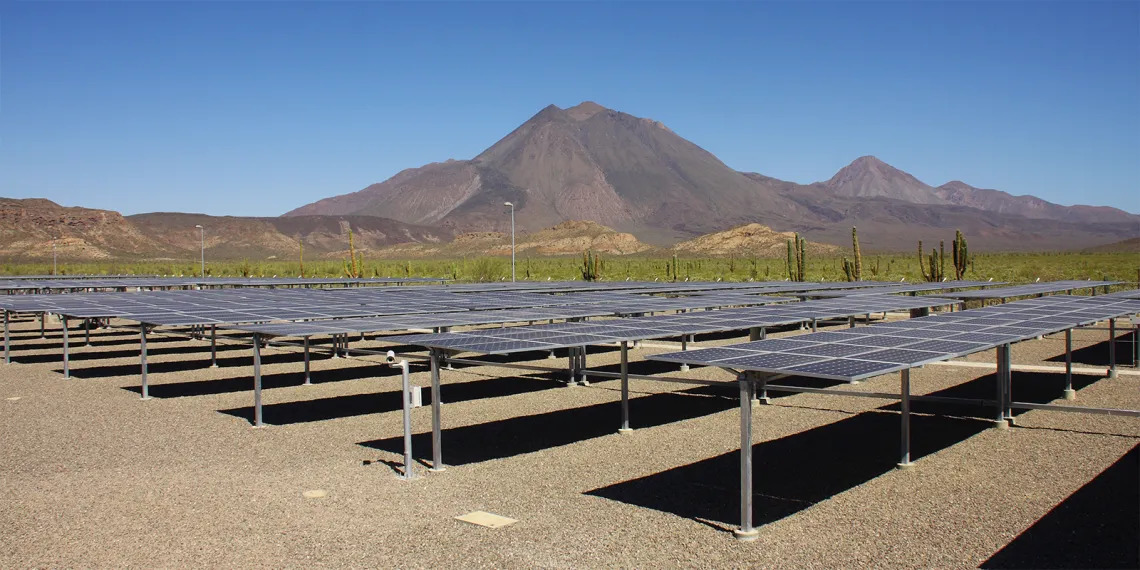The possibilities for solar, which is under-utilized in Mexico, have started to shine brighter.
Although the Sonoran Desert has an abundance of sunshine and vast expanses of open land—the essential elements for a successful solar installation—renewable energy has historically been underutilized in the region. Fortunately, Mexico’s renewable energy future looks vastly different than its present.
Until 2013, when then-president Enrique Peña Nieto succeeded in amending the constitution to open up the energy market to private companies, two state-owned utilities, Petroleos Mexicanos (oil) and the Comisión Federal de Electricidad (electricity), powered the entire nation. The reform led to the creation of an independent utility, Centro Nacional de Control de Energía and provided transmission rights to private companies.
Energy reform is a key element in achieving renewable energy targets in Mexico. Currently, the country generates an estimated 23 percent of its power from renewable energy such as wind, hydropower, geothermal and solar power, according a 2018 report.
With the 2012 adoption of the General Climate Change Law, the nation committed to sourcing at least 35 percent of its power from renewable sources by 2050, which still falls far below the current average of 50 percent across Latin America.
“Solar is a big thing right now but it’s not up to its full potential,” says Christian Davila-Peralta, a doctoral student at the University of Arizona. “We have a lot of resources, especially in solar, that [are not being used]; we have to exploit the fact that we have a single utility line so we could produce enough [solar] energy in the north for all the country.”
Davila-Peralta blames both infrastructure and red tape for slow adoption. CENACE, he explains, requires all solar installation sites to have internet access with a fixed IP address, which is expensive and unavailable in certain areas; licensed technicians are required to certify installations for entities, like businesses, and the wait times are long. There is also a perception that solar installations required complicated paperwork to establish.
Shining a Light on Solar
Despite the struggles, solar power is becoming more common. The trade war between the United States and China has diverted cheap solar panels to Mexico, making solar more affordable. There is also a growing awareness that solar provides energy independence and bolsters national safety.
“Right now, the government has been investing in a lot on natural gas…which is good because they are greener than the ones that we used to have with direct oil or carbon,” Davila-Peralta says. “The problem is that Mexico is not a huge producer of natural gas so we depend on the natural gas sale with the U.S. and [if those lines are closed], we only have three days of [electricity] storage. Our economy can collapse in three days if you just close the lines.”
Advanced solar technologies could bring new opportunities to Mexico and researchers on both sides of the border or laying the groundwork to develop the future of solar.
At the UA, Roger Angel, a professor and founder of REhnu, a corporation developing solar power generators, is exploring how mirrors can be used to collect light as an alternative to conventional photovoltaic panels. The idea, he explains, is that light could be concentrated, making solar power less expensive and more powerful than silicon.
Angel is also conducting research to determine how to generate electricity after the sun goes down. The mirrors can be directed to heat up a substance like liquid salt that is stored at 500-600 degrees in a tank and, in the evenings, a turbine drives an electric generator to produce power.
The research is being conducted in conjunction with the Consortium for Arizona-Mexico Arid Environments (CAZMEX) and the University of Sonora and carried out in a test facility near Hermosillo, Mexico.
“The need gets ever stronger to do something to get off carbon,” Angel says. “We have this joint project to make what should fundamentally be a cheaper way to … get more solar energy into the system; if we want to meet the 2050 targets for CO2 … we need to get solar energy use up to 20 percent during the day and an additional 10 to 15 percent of power coming from stored solar energy at night. Sonora has this incredible resource and we need to use that.”
Thanks to long-awaited progressive energy reform in Mexico and cross-border collaborations to develop new technologies and bolster national energy security, Davila-Peralta believes the future of clean energy in Mexico is bright.
“A lot of research in solar at the University of Arizona can be applied directly to create value down in Mexico by means of technology transfer, business development and professional development,” he says. “Sonora is the place to develop proof of concept.”


